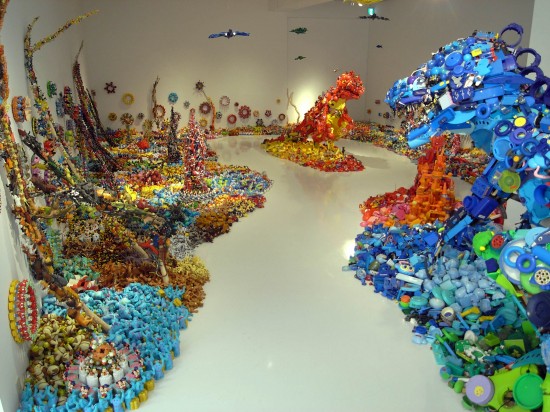Exhibition 1
Hiroshi Fuji and the Uncharted Land of Toysaurus
Venue: Gallery A
July 5 (Saturday) – October 5 (Sunday), 2014
Hundreds of thousands of brightly colored plastic toys collected from children from around the world. These toys gave birth to Toysaurus, a toy dinosaur that suddenly appeared at an art museum at the foot of the Haruna Mountains, in the uncharted land where it lives…

Hitoshi Fuji, Toys Paradise, 2010, 3331 Arts Chioda
The artists Hiroshi Fuji is known for his unique activities that create platforms in which people can dialog with one another and create new relationships on a voluntary basis. For this exhibition, Fuji used an uncountable number of small plastic toys and twigs from the museum grounds.
One of the things engaged in by Fuji and his family is the Kaekko Bazaar, which now has a history of traveling throughout Japan. Through this miraculous system, once-loved but now discarded toys are once again taken up by human hands, sorted and brushed up. Now, in the form of Toysaurus, these toys once again see the light of day and are given new life. Why not join us to explore this uncharted land and listen to the story of Toysaurus?
(Note: For the first time in Japan, actual footprints of a dinosaur were discovered in the southwestern part of Gunma Prefecture.)
Hiroshi Fuji (Artist, Director of the Towada Art Museum)
After completing a B.A. and an M.A. at Kyoto City University of Arts, Fuji joined Japan International Cooperation Agency and worked as a lecturer at the former Papua New Guinea National Arts School. He went on to join an urban planning group, and after that established the Fuji Hiroshi Design and Production Studio. He carries out projects in numerous regions engaging in dialogue and community experiments, such as the Vinyl Plastics Connection (Kaekko) and others. He showed work at the Hara Annual V exhibition (1985) at the Hara Museum of Contemporary Art, created an on-site work at Hara Museum ARC in 1989, and showed work in the Art is Fun exhibition in 1990 at Hara Museum ARC. He is currently active in Fukuoka and Aomori prefectures. http://geco.jp
[Related Event]
A Hiroshi Fuji workshop for the young and old alike
Kaekko Bazaar
Venue: Hara Museum ARC
Every Saturday and Sunday in August; September 13, 14, 20 and 21; October 4 and 5, from1:30 pm
Kaekko is a workshop, first launched in Fukuoka in 2000, in which children use specially designed currency called “kaeru (frog) points” in various activities that they develop on their own. The name is based on the Japanese word “kaeru” which can mean “frog” or “to return”. The workshop has been conducted in over 1,000 places, throughout Japan, including schools, nurseries, shopping streets, parks, public halls, private homes, museums and recycle centers. Toys that children no longer want can be exchanged for frog points, which in turn can be used to receive another toy. The system is supported by many people now as a way of keeping toys in continuous circulation throughout the world.
☆ Even if they do not bring a toy, participants can earn frog points by helping out with the museum workshop, with special Kaekko programs, or sorting toys.
—————————————————————-
Exhibition 2
Big Small Wide and Tall – Selections from the Hara Museum Collection
Venue: Gallery B・C
July 5 (Saturday) – October 5 (Sunday), 2014
Something big, something small, something shaped, something colored, something bright: what waits for you behind the door?
[Featured Artists]
Yayoi Kusama, Tabaimo, Satoshi Ohno, Surasi Kusolwong, Jason Teraoka and others
===================================================
The following events will be held during this period:
Exhibition: Pictures That Tell a Story
Dates: [Part I] July 5 (Saturday) – August 20 (Wednesday) [Part II] August 22 (Friday) – October 5 (Sunday), 2014 Venue: Kankai Pavilion
Workshop I: Let’s Make Art Fans!
Date: August 2 (Saturday), 3 (Sunday), 9 (Saturday), 10 (Sunday) Venue: Corridor Time: 10:00 am, 1:00 pm, 3:00 pm
Workshop II: Nakadai Ikaho Factory: Mono Factory x Hara Museum ARC
Date: August 13 (Wednesday) -17 (Sunday) Venue: Corridor Time: 10:00 am – 4:00 pm (last registration at 3:30 pm)
Talk Event
Hiroshi Fuji (artist, director of the Towada Art Museum) x Sumiyuki Nakadai (manager, Maebashi Branch, Nakadai Co. Ltd.)
Moderator: Kazuko Aono (curator, Hara Museum of Contemporary Art)
Date: August 17 (Sunday) Time: 5:00 pm – 6:30 pm
===================================================
Hara Museum ARC
Address: 2855-1, Kanai, Shibukawa-shi, Gunma 377-0027
Tel 0279-24-6585 Fax 0279-24-0449 E-mail arc@haramuseum.or.jp
http://www.haramuseum.or.jp (official website) http://mobile.haramuseum.or.jp (mobile site)
https://www.art-it.asia/en/u/HaraMuseum_e (blog) http://twitter.com/HaraMuseumARC (Twitter)
Hours: 9:30 am – 4:30 pm (last entry at 4:00 pm)
Closed: Thursdays (except during the month of August) *Closed temporarily in the event of severe weather.
Admission: General (over 12) 1,100 yen, Students 700 yen (high school and university) or 500yen (elementary and junior high), Free for Hara Museum members; 10% discount for a group of 20 or more; Combination ticket for Hara Museum ARC and Ikaho Green Bokujo (except during Golden Week): General 1,800 yen; Students 1,500 yen (high school and university) or 1,400 yen (junior high), 800 yen (elementary) *Children must be accompanied by an adult.
Getting There: By train: Take the Joetsu Shinkansen to Takasaki, change to the Joestu Line, and disembark at Shibukawa. From Shibukawa, ARC is 10 minutes away by taxi or 15 minutes by bus (take the Ikaho Onsen bus to ″Green Bokujo Mae″). By car: 8 kilometers (about 15 minutes) from the Kan-etsu Expressway Shibukawa Ikaho Interchange (in the direction of Ikaho Onsen).
《Access》 Suggested Timetable
When using the Joetsu Nagano Shinkansen
● 8:04 Tokyo Station 〈Shinkansen Max Tanigawa 403〉→ 9:02 Takasaki Station
9:12 Takasaki Station Joetsu Line (Local train for ″Naganohara Kusatsuguchi″) → 9:38 Shibukawa Station
9:44 Bus (for ″Ikaho Onsen″) → 10:10 ″Green Bokujo Mae″
● 9:20 Tokyo Station 〈Shinkansen Asama 511〉→ 10:09 Takasaki Station
10:31 Takasaki Station Joetsu Line (Local train for ″Minakami″) → 10:56 Shibukawa Station
11:03 Bus (for “Ikaho Onsen”) → 11:22 ″Green Bokujo Mae″
●11:16 Tokyo Station 〈Shinkansen Max Toki 319〉→ 12:06 Takasaki Station
12:22 Takasaki Station Joetsu Line (Local train for ″Minakami″) → 12:47 Shibukawa Station
12:53 Bus (for ″Ikaho Onsen″) → 13:08 ″Green Bokujo Mae″
When using the JR Limited Express Train ″Kusatsu″
*Operates only on Saturdays, national holidays and Sundays.
● 09:00 Ueno (Kusatsu 31) → 10:39Shibukawa
10:45 Bus (for Ikaho Onsen) → 10:56 ″Green Bokujo Mae″
●10:00 Ueno (Kusatsu 1) → 11:44 Shibukawa
11:50 Bus (for Ikaho Onsen) → 12:01 ″Green Bokujo Mae″
●12:10 Ueno (Kusatsu 1) → 13:52 Shibukawa
13:57 Bus (for Ikaho Onsen) → 14:08 ″Green Bokujo Mae″
*Please double check the timetable on the day of your departure.
JR Jyoshu Yumeguri-GO (Shinjuku Station ⇔ Shibukawa・Ikaho Onsen)
http://time.jrbuskanto.co.jp/bk040450.html
Kanetsu Kotsu Bus Timetable (Shibukawa Green Bokujo・Ikaho Onsen)
http://kan-etsu.net/files/lib/5/53/201403081227596826.pdf
